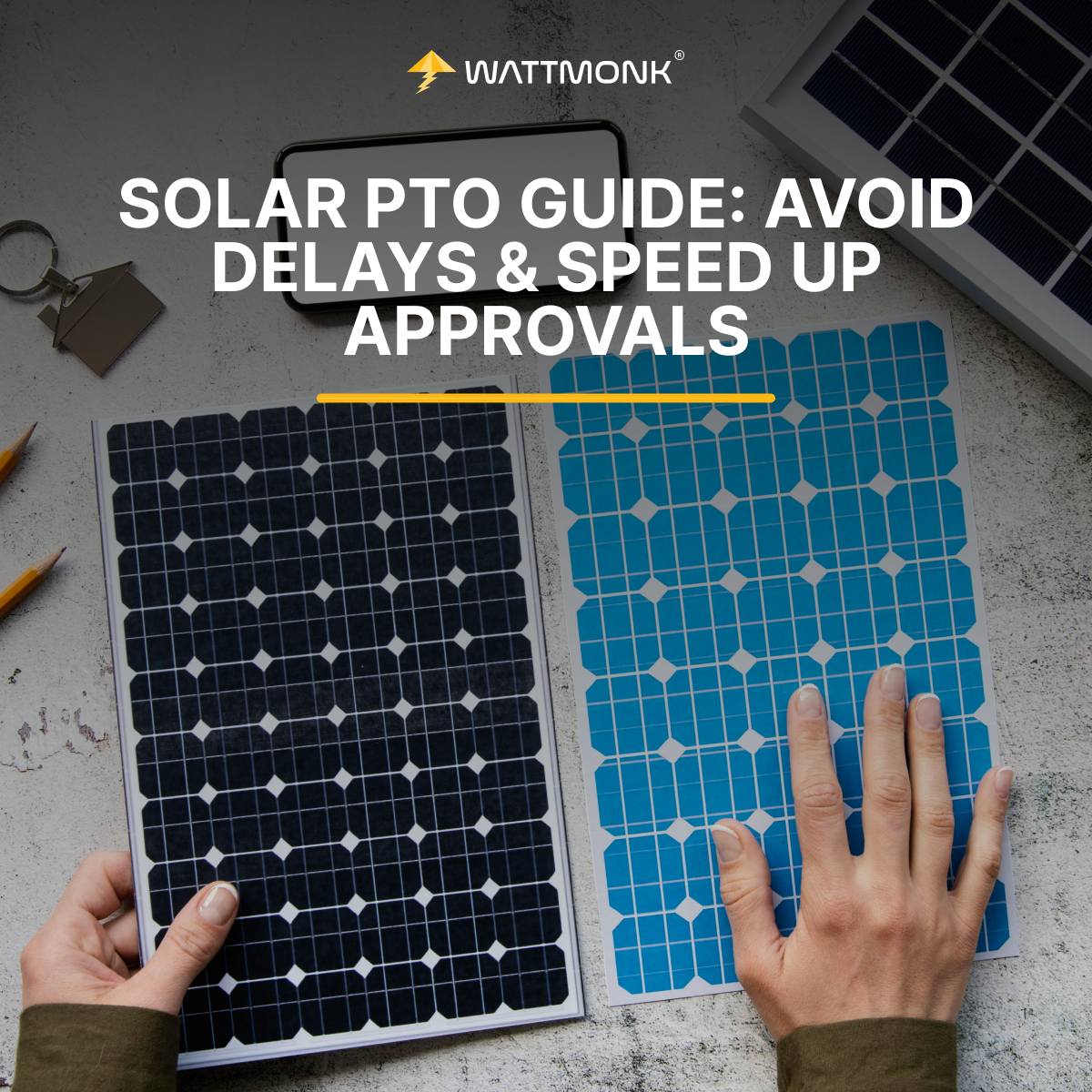Did you know that 1 in 5 projects get delayed because of solar PTO and utility approvals? That’s weeks or even months of waiting after installation, just to flip the switch. For installers and homeowners alike, these delays can cost time, trust, and money.
PTO or permission to operate isn’t just paperwork. It’s the final step before a solar system goes live. But many people don’t realize how easy it is to get stuck in the process, especially with changing utility rules, missed documents, or small design errors.
A third of solar customers say post-installation delays are their biggest frustration. And on commercial projects, nearly 1 in 3 still need design changes after utility review. This guide will show you how to avoid those roadblocks.
We’ll walk through the PTO process, key timelines, and how Wattmonk helps get your system connected — fast
What Is Solar PTO & Why It Matters?
Think of solar PTO (permission to operate) as the green light from your utility company. It’s the final approval you need before a newly installed solar system can be switched on and connected to the grid.
While you may feel “done” when the solar panel installation is complete, the system isn’t legally allowed to generate and send power until the utility signs off. This makes PTO not just a technical requirement, but a critical step in the project journey.
For homeowners, delays in solar PTO can mean weeks of lost savings and growing impatience. For installers, it ties up cash flow, disrupts schedules, and increases the risk of customer dissatisfaction. And for commercial projects, the stakes are even higher, especially when grid compliance, performance contracts, or financing deadlines are involved.
In short, PTO unlocks the value of the entire solar project. Which is why understanding the process, planning for utility timelines, and avoiding rework is essential to keeping your installs on track.
Roadmap To Solar PTO Approval
Getting solar PTO may seem like a waiting game, but it’s actually a series of coordinated steps—each one important to avoid delays. Whether you’re installing residential or commercial systems, understanding this roadmap helps you stay in control and set clear expectations with your customers.
Step 1: Final Inspections
Once installation is complete, a local authority (AHJ) inspects the system for code compliance—checking things like wiring, mounting, and safety protocols. Without this clearance, utilities won’t review your interconnection request.
Step 2: Submit Interconnection Application
The next step is sending your paperwork to the utility. This includes system specs, site plans, permits, and proof of inspection. Incomplete or mismatched documents are one of the most common reasons for PTO delays.

Step 3: Utility Review & Meter Installation
After approval, the utility schedules a meter change or reprogramming—so the system can export excess power to the grid. This step often accounts for most of the wait time.
Step 4: Permission to Operate (PTO) Granted
Once the utility finishes its checks, it sends formal PTO—usually by email. Only then can the system be turned on and start producing power.
Interconnection, Utilities, and Timelines
To receive solar PTO (Permission to Operate), your system must be interconnected with the utility grid—meaning it can safely send and receive electricity. But what sounds like a simple connection is actually a regulated, multi-step process that varies across states, utilities, and project sizes.
What Is Interconnection in Solar?
Interconnection refers to the utility’s formal approval for your solar system to interact with the grid. It ensures your system won’t overload transformers, disrupt local power flow, or pose safety risks to utility workers.
Each interconnection application is reviewed by your utility provider, who checks if your system meets technical standards (like voltage, inverter specs, and breaker sizing) and regulatory requirements.
Why Does It Take Time?
The utility needs to confirm:
Your system matches the approved design
Safety and electrical codes are followed
Local grid infrastructure can support your system
All permits and inspection approvals are in place
Utilities now receive a surge in interconnection requests—especially in solar-heavy states. This, combined with manual review processes and staff shortages, leads to longer wait times.
Typical Timelines
The best way to avoid delays is early preparation. Submitting accurate documents, following utility-specific formats, and working with experienced permitting partners can help you move smoothly through the approval pipeline—and speed up that final PTO.
Below is a typical timeline for different sectors:
Residential projects: 6–12 weeks for full interconnection and PTO
Commercial projects: 10–20+ weeks depending on complexity and grid availability
Fast-track approvals may exist for small systems under specific wattage thresholds, but they still require documentation
Solar PTO in Complex Installations: Batteries, SGIP, and Utility-Scale Systems
While solar PTO is already a detailed process for standard installs, the complexity increases significantly when energy storage, incentive programs, or large-scale systems are involved. These elements introduce new approval layers and often, new delays, unless planned for early.
Battery Storage Systems Require Extra Review
Adding a battery (like a Tesla Powerwall or Enphase IQ) means utilities must also evaluate how stored energy interacts with the grid. They’ll review:
Export limits and grid safety
Load offset strategies
Backup vs. grid-tied configurations
In some cases, your system might require an interconnection study, adding 2–4 weeks to the timeline. Some jurisdictions also require separate permits for battery installation.
SGIP and Incentives Mean More Paperwork
If your project participates in incentive programs like Self-Generation Incentive Program (SGIP), additional steps enter the workflow:
Pre-application reviews
Documentation of backup power use cases
Energy storage system specs and warranty data
Each step must be validated before solar PTO is granted. Missing one form can send you back to the queue.
Utility-Scale Projects Come With Grid Impact Studies
For commercial and utility-scale systems, utilities often conduct grid capacity and impact studies before approving PTO. These studies assess whether the local grid can handle the power being fed in and if infrastructure upgrades are needed.
That’s why commercial developers often see timelines of 4–6 months or more, especially in congested or rural areas.
Smart Tip: Map out your solar PTO journey before design finalization. Understanding how batteries, incentives, or scale affect your timeline allows you to better plan with clients and avoid redesigns late in the process.
Accelerate Your PTO Timeline with Wattmonk
If there’s one thing every installer and customer agrees on, it’s: solar PTO delays are frustrating. They hold up final payments, stall system activation, and eat into customer satisfaction. But delays don’t have to be unavoidable.
Wattmonk’s solar PTO and interconnection services are built to solve exactly this problem—by bringing speed, structure, and strategy to the approval process. We streamline your project with pre-vetted plan sets designed to meet utility requirements from the start—minimizing costly back-and-forth corrections.
Our team is well-versed in utility-specific documentation, including submission formats, naming conventions, and technical specs, ensuring your application is complete and correctly submitted the first time. We also offer full interconnection support, whether you’re applying through PG&E’s portal or uploading documents to Duke Energy. From form fill-out to final submission, we’re with you at every step.
Choosing us means: Fewer rejections. Faster approvals. And more control over your project timelines.


